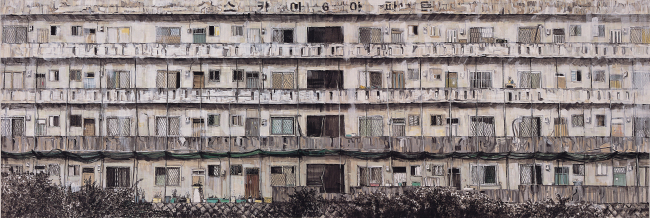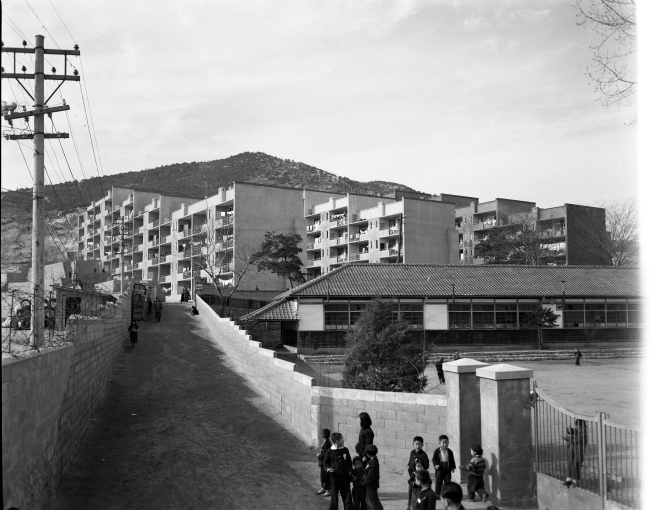Apartments, dream home for Koreans
Exhibition sheds light on high-rises’ unusual place in Korean society
By Lee Woo-youngPublished : March 19, 2014 - 19:38
Among many features that define the cityscape of Seoul, one thing makes the capital distinct. That’s the gray skyline along row after row of near identical concrete apartments.
The sea of concrete high rises stemmed from a public housing project initiated in the 1970s to accommodate the mounting urban population efficiently. It has now become the type of residence most preferred by a majority of Seoul citizens.
An exhibition at Seoul Museum of History takes the audience on a journey through the history of Korean apartment development and looks into the influence of apartments on Koreans’ lifestyle.
The sea of concrete high rises stemmed from a public housing project initiated in the 1970s to accommodate the mounting urban population efficiently. It has now become the type of residence most preferred by a majority of Seoul citizens.
An exhibition at Seoul Museum of History takes the audience on a journey through the history of Korean apartment development and looks into the influence of apartments on Koreans’ lifestyle.

A real apartment unit is on display in the exhibition hall to offer a look at a standardized apartment from the 1970s and 1980s, which consists of a living room, a kitchen and three bedrooms for a family of four. The interior of the unit was moved to the exhibition hall as the building was to be demolished as part of the city’s redevelopment project.
The three-bedroom apartment unit, built 36 years ago, is a symbol of the emerging middle class in the Korean society of the 1970s. The 75-year-old retiree, who used to reside in the unit on display, was born in the southern port city of Busan, studied hard to enter a college in Seoul and landed a job at a large company in the capital city. His 71-year-old wife, a Daejeon native, has accumulated wealth by moving from apartment to apartment, leading the typical lifestyle of middle-class Koreans.
According to Park Cheol-soo, architecture professor at University of Seoul, apartment is a keyword that explains Korean society and Koreans.
“They (middle-class apartment dwellers) shop at supermarket chains on the weekends, dine at family restaurants. They are always keen on prices of apartments and their children’s education,” he said.

Living in an apartment was a symbol of wealth in the 1970s and 1980s. A photo taken by a Seoul citizen in the 1980s has a caption that reads “living in the Hangang River Mansion was a symbol of prosperity and pride.” Apartments with a view of the Hangang River are considered to be most expensive in Seoul.
Records by different Seoul residents, which are hung alongside the pictures, describe life in apartments.
Apartments, however, are not without downsides. Their expansion caused the eviction of defiant tenants in shanty towns slated to be developed into apartment towns. The old neighborhoods of small decrepit housing, inhabited mostly by hundreds of thousands of migrants from the provinces, have been gradually pushed aside by high-rise apartment complexes, forcing most of them to leave when they couldn’t afford the modern housing.
Apartment projects sometimes entailed violent clashes between tenants who defy eviction and builders.
A section devoted to violently evicted tenants shows that about 20 percent of the Seoul population had to leave their houses in the 70s.
Redevelopment is still ongoing in some underdeveloped areas of Seoul. A section displays pictures taken by apartment residents in Duchon LH Apartment, which is about to be demolished due to a city redevelopment project. The pictures portray happy memories in a soon-to-be-gone hometown ― sledding on a hill in winter and playing in the playground.
Photographer Ahn Se-kwon’s panoramic image of Wolgok-dong, a northern town in Seoul where new apartments have been built on top of the old neighborhood recently, shows two contrasting scenes in the photo. The left side shows well-lit newly built apartments while the right side of town is full of old houses that remain dark.
Other contemporary artists present different perspectives of apartments through paintings, photographs and installations depicting lives, memories and even humor associated with living in apartments in Korea.
The exhibition “The Republic of Apartments” continues through May 6 at Seoul Museum of History in Saemunan-ro 55 in Jongno, Seoul. For more information, visit www.museum.seoul.kr.
By Lee Woo-young (wylee@heraldcorp.com)







![[KH Explains] How should Korea adjust its trade defenses against Chinese EVs?](http://res.heraldm.com/phpwas/restmb_idxmake.php?idx=644&simg=/content/image/2024/04/15/20240415050562_0.jpg&u=20240415144419)










![[Today’s K-pop] Stray Kids to return soon: report](http://res.heraldm.com/phpwas/restmb_idxmake.php?idx=642&simg=/content/image/2024/04/16/20240416050713_0.jpg&u=)